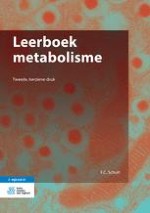Gepubliceerd in:
2015 | OriginalPaper | Hoofdstuk
12. Lichaamsmetabolisme
Samenvatting
In hoofdstuk 12 integreren we eerder aangebrachte elementen tot een globaal beeld van lichaamsmetabolisme. We bekijken hierbij de enorme metabole verschillen tussen organen en twee belangrijke parameters: het handhaven van een normale bloedglucoseconcentratie (glucosehomeostase) en het bewaken van een normale body mass index (homeostase van de triglyceridenvoorraad). Aandacht verdienen de sterke invloed van de voedingstoestand (gevoed, tussen maaltijden, vasten) en hoe insuline, glucagon, adrenaline en cortisol de flux in metabole wegen veranderen. Ook besteden we aandacht aan metabole veranderingen in skeletspieren om kortstondige of langdurige arbeid te ondersteunen. Vervolgens bekijken we diabetes (suikerziekte) als ontsporing van de glucosehomeostase en de rol van pancreatische bèta-cellen die ofwel vernietigd worden door het immuunsysteem (type-1-diabetes) ofwel slecht functioneren (type-2-diabetes). We eindigen met metabool syndroom en obesitas, waarbij we aandacht besteden aan de complexe wisselwerking tussen een recente verandering in ‘westerse levensstijl’ en een door langdurige selectie aanwezige genfunctie.
